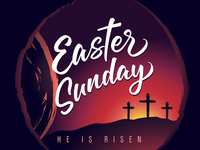- Sections :
- Crime & Public Safety
- Restaurants & Food
- Sports
- More
The Woodlands celebrates Holy Week

THE WOODLANDS, TX – For those who celebrate the Christian calendar, the Lenten season is nearly over as The Woodlands – and the rest of the world – entered Holy Week this past Sunday. Specific days are marked for celebration or commemoration, culminating in Easter Sunday this weekend.
Historically through the centuries, springtime has been a significant yearly event for religions of all ages and types. This week, Indians throughout the world celebrate Mahavir Jayanti, the birthday of Jainism founder Lord Mahavira, Jews observe the seven-day holiday of Passover, and Christians celebrate Easter Week. Also in this month, Sikhs will celebrate springtime harvest with Vaisakhi and Musliums will mark the end of month-long Ramadan with Eid al-Fitr and the large feast that goes along with it.
The ubiquitous nature of the Christian Holy Week, however, can’t be overstated; in 2021, national polls indicated that nearly 80 percent of all Americans celebrated Easter in some way. Even myriads of nonreligious people opt to give up something for the 40-day period of Lent as a sort of springtime New Year’s Resolution. The mainstreaming of these celebrations even reach into everyday life; the venerable Filet o’ Fish sandwich at McDonald’s, for instance, was created in 1962 by Lou Groen in response to massive drops in hamburger sales on Fridays during Christian meatless observances.
Throughout The Woodlands, the weeklong celebration goes far beyond just the namesake Easter Sunday. Most people are also familiar with Palm Sunday, and Good Friday, but perhaps not the other named days of the celebration, and likely not all the reasons behind the commemorations. Last month, the Lenten season was kicked off on Ash Wednesday – off the heels of Mardi Gras, aka Fat Tuesday, a pre-Lent day of excess to prep for the 40-day/night observance of sacrifice – with thousands of local Woodlands area worshippers hitting local churches to commit to Lent and be marked with ashes as a sign of that commitment. Now, six weeks later, Holy Week marks the final week of Lent.
Last Sunday marked the onset of the holy week by commemorating the arrival of Jesus in Jerusalem riding on the back of a donkey, with followers laying palm tree fronds in his path in honor of his return. Palm Sunday started at sundown that day and is typically marked by religious leaders handing out balm fronds to their congregations, sometimes fashioned in the shape of a cross.
Monday, Tuesday, and Wednesday of this week are known as Holy Days with special church services reading relevant passages from the Christian Bible being a mainstay of marking the event. Wednesday of this week is also known as Spy Wednesday, named due to the related story of Judas betraying his friend to the chief priests of Jerusalem. Services in many houses of worship include extinguishing candles in an event called Tenebrae.
Unknown by name to many, the next day is known as Maundy Thursday, named in commemoration of the activity of washing of feet. This day marks the occasion of the Last Supper, and at sundown the season of Lent officially ends and the Easter Triduum (three-day observance) begins. The only Mass allowed by the Catholic Church on this day is the Mass of the Lord’s Supper. In Methodist and Lutheran churches, the altar has black paraments or the altar cloths are removed altogether, and most other images – such as the altar cross – are veiled. In the Catholic Church, crosses are removed from the church (or veiled), crucifixes and statues are covered with violet covers during Passiontide, but the crucifix covers can be white instead of violet on this day.
The ‘work-week’ aspect of Holy Week ends on Good Friday, marked in the secular world as a school holiday (but – coming as a surprise to many – not a bank holiday, although some businesses may conduct special hours that day). This high holy day marks the crucifixion of Jesus and his subsequent death on the cross. The day is filled with observances of what is known as ‘The Passion of the Christ.’ For many denominations, it is a day of fasting and reflection, and remembrance rather than celebration.
The day between Good Friday and Easter Sunday actually has a name that few know; Black Saturday (although it too is also known as Holy Saturday). Typically, there are no daytime worship services, but at sundown the official Easter Vigil observance begins. Many churches are dimmed indoors in reflection of the entombment of Jesus. Also, technically, this is when Holy Week ends; Easter Day is the first day of the new season of the Great Fifty Days, or Eastertide, which runs from Easter Day to Pentecost Sunday.
Whether or not you celebrate Easter, Woodlands Online wishes you a peaceful and reflective week and weekend.




















